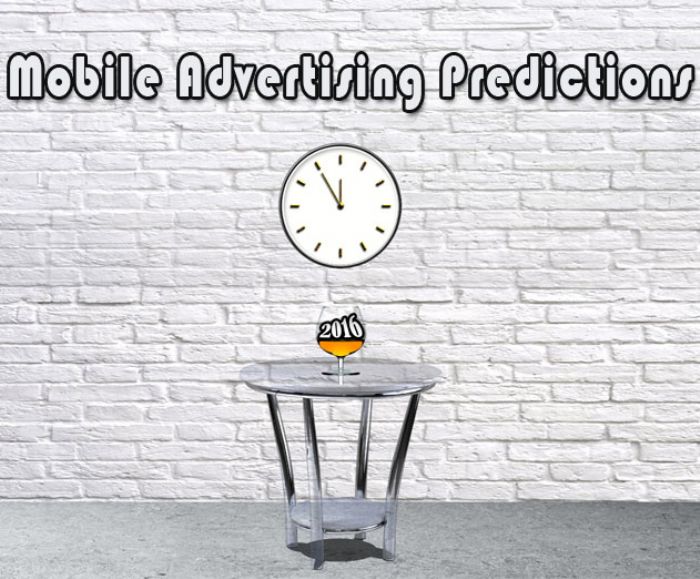Mobile Advertising Predictions for 2016
Wednesday, January 6, 2016

|
Stuart Parkerson |
Predicting what the future holds for mobile marketing is no easy task, especially because the market itself changes so quickly. But Fiksu weighs in with some great advice to prepare yourself for the changes that might be coming in mobile marketing over the next year.
We recently hosted a Q&A with members from Fiksu’s executive team who offered their predictions on mobile advertising for 2016. Included in the Q&A were Fiksu’s Tom Caputo, Chief Product Officer; Benjamin Hansz, VP of Client Management; Claire Oliverson, Director of Product Marketing; Craig Palli, CSO; Pat Eichmann, Senior Director of Sales West; and Tom Cummings, Client Accounts Director.
ADM: What will be the top challenge facing brands as they try to reach mobile audiences?
Caputo: As the focus continues to move towards mobile, media buyers are getting more sophisticated. Mobile marketing expertise is seen as crucial enough that brands want those experts in-house, and at the same time they're demanding that their ad tech partners give them the tools they need to succeed. That means more self-serve capabilities, more ecosystem integrations, broader functionality, and more effective tools.
Hansz: The number one challenge facing brands will be their internal adjustments to performance marketing. Or put another way, the "winners" will be those brands that are able to incorporate all the analytics and reporting that the mobile ecosystem provides, analyzing that data for insights and then acting on those insights in their next campaigns.
Oliverson: Integrating performance and tracking with their existing multi-channel marketing will be top of mind. Until a true omni-channel measurement solution is created, the game of trying to match GRPs against impressions, clicks, engagements, app downloads, etc., will continue to be a major challenge.
ADM: Which of the big platforms will dominate mobile advertising in 2016?
Palli: Google and Facebook will continue to grow their dominant position while a handful of other key players, notably Yahoo and AOL/Verizon, seek to hone their offerings and begin winning market share. In addition, specialists such as Opera Mediaworks' and AdColony will continue to excel with key media formats like video. Video is certainly rising with AdColony, YouTube and the big emergence of Facebook video.
Caputo: Instead of a platform, I'll mention a format: video. Right now, it's no secret that the mobile video advertising experience isn't that great – in-app or on the mobile web. Mobile video ad performance has been improving over the last year: RTB exchanges and video ad networks are investing in improving the end user experience by providing more integrated, immersive, and relevant ad units, which will also drive better performance for advertisers. That will give video ads even more momentum, improve the diversity of mobile video ad units and lift video adoption rates for all types of advertisers.
ADM: Will there be room for niche mobile advertising channels?
Oliverson: Yes, there will be room for niche mobile advertising channels. Many advertisers are still interested in testing and learning with mobile, as it hasn't hit the early or late majority stages of the adoption curve yet. We're seeing fewer niche players succeeding in the space as the mobile market matures, but there's still room today for these channels.
Caputo: Whether its niche players or other major platforms, I think we can expect some diversification away from Facebook. Brands and app publishers want partners that are able to support media and audience buying across multiple platforms. Whether they're targeting audiences for brand awareness, re-engagement, or performance-based user acquisition, they're beginning to understand the value in targeting specific users wherever they are – instead choosing the channel first. They're also looking to maximize scale – while Facebook is far and away the biggest single channel, there is plenty more inventory out there.
ADM: What's the most common type of targeting on mobile today? And what will it be next year?
Oliverson: The most common type of targeting on mobile today is exactly what you would think: those who are tough to reach on other channels, and those who are most engaged on mobile. We see folks like Millennials getting a lot of traction as well as family oriented people who are in control of household spending.
Cummings: The most common segment people want to reach is the "whale." But it’s also the most elusive and differs for each brand. So what is it? A whale is the user willing to spend a lot of money within your app. It comes from the casino term for high-rollers, and is most common in the mobile game world, where whales account for up to two-thirds of in-app purchase revenue.
In the past, mobile marketers needed to find large spending users by building demographic profiles, targeting specific publishers, or encouraging interaction within the app (through game play or push notifications). Brands should obviously continue to do these things, but advanced targeting options and data modeling product offerings will allow for brands to find more of these users simply by building off their current user base. By knowing who your high spending users are you can use lookalike modeling to let ad networks programmatically find more people like them.
ADM: How do you see the next chapter of the ad blocking saga playing out from a consumer, publisher and advertiser standpoint?
Palli: First of all, ad blocking's impact on advertisers is a bit over hyped. Ad blocking mainly impacts mobile web and, therefore, a subset of 10 percent of the mobile ad market. That said, consumer sentiment leading to ad blocking is real. While some marketers understand their consumers and how to reach them, the majority of advertisers advertise to improperly vetted audiences-- creating further frustration. As smart advertisers see poor or declining results, they will increasingly seek to move towards improving their targeting and thereby will improve performance, while helping to strike the right balance with consumers.
ADM: What changes do you predict for the Apple App Store in 2016?
Cummings: As apps become a more integral part of the marketing media mix of major brands, expect Apple's App Store to continue to mature to serve their needs. That means more predictability, more transparency, and the ability for brands to impact their visibility in planned ways.
Volume and velocity of downloads has been the primary driver of rank placement for several years, and 2016 will be the year that starts to change. While sheer number of downloads will always be a major driver, I expect usage, registrations, in-app purchases, and uninstall rates to begin to impact apps' Top Charts ranks within their categories (categories which, incidentally, will continue to evolve and expand). Most importantly, be ready for sponsored ads within the App Store, allowing brands to promote their apps at precise times - while also providing another inventory option for iAd and revenue stream for Apple.
We've also seen recent shifts in search functionality that base rankings on more complex factors than simple keywords, an indicator that Apple is starting to leverage their 2012 acquisition of Chomp. As this expands, users will continue to be able to better find apps based on searching for their features and functionality, not just their names. In the end, 2016 will be a win-win-win for developers/brands, Apple, and users: more ways to promote your app, more revenue streams, and a better way to find the app that you need.
ADM: What will work best in creative in 2016? Will this be a differentiating factor in campaign success?
Eichmann: Now that programmatic buying has become the standard for evaluating and purchasing ad placements, the next logical conversation we need to have as an industry should revolve around the quality of the creative units we are pushing out to consumers via these channels.
I've been amazed to see so many major brands carefully evaluate a DSP's ability to reach a specific cohort of consumers at the right time and in the right place – to only utilize underwhelming generic messages. If we really want to live up to the true potential of mobile we need to do a better job of incorporating mobile data, specifically identifiers, into the creative development conversation. 'Programmatic Creative' does exist, but what I am predicting takes this concept a step further. Imagine a world where mobile marketers are able to synthesize their first party identifiers with third party data in order to obtain a view into each creative asset ever served to a specific consumer.
What If I could tell a customer that 20 percent of their most loyal users have historically responded better to blue 'buy now' buttons vs. yellow ones? Or if they respond to pictures of mountains vs. pictures of oceans. The learnings could have a profound impact on how brands think about interacting with customers vs. their prospects. We know IDFAs and Google IDs can contain a vapor trail of historical data and, in many cases that information can change the way brands communicate with their target audiences.
In 2016, I predict we will see more vendors talk about how they can incorporate data sets to provide creative guidance to their customers. It may not be the year of 'Programmatic Creative' but I don't think we are too far off.
Read more: https://www.fiksu.com/

Become a subscriber of App Developer Magazine for just $5.99 a month and take advantage of all these perks.
MEMBERS GET ACCESS TO
- - Exclusive content from leaders in the industry
- - Q&A articles from industry leaders
- - Tips and tricks from the most successful developers weekly
- - Monthly issues, including all 90+ back-issues since 2012
- - Event discounts and early-bird signups
- - Gain insight from top achievers in the app store
- - Learn what tools to use, what SDK's to use, and more
Subscribe here




_cptybzmh.jpg)








